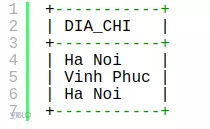RDBMS stands for Relational Database Management System, which means relational database management system. RDBMS is the basis for SQL, and for all modern database systems such as MS SQL Server, IBM DB2, Oracle, MySQL and Microsoft Access.
1. What is a table?
RDBMS Database uses tables to store data. A table is a collection of related data and contains rows and columns for saving data. A table is the simplest data storage in a RDBMS. 
2. What is a Field?
The field, which is the smallest entity of the table, contains specific information about each record in the table. In the example above, the fields in the KHACH_HANG table include ID, TEN, TUOI, DIA_CHI AND LUONG.
3. What is the row or record?
A row of a table is also called a record. It contains specific information about an individual entry in the table. The row is a horizontal entity in the table. 
4. What is a column?
A column, which is a vertical entity in a table, contains all the information associated with a specific field in a table. For example, a column in the CLIENT table is DIA_CHI, which describes the location and will look like this: 
5. What is a NULL value?
The NULL value of a table determines that the field was left blank while creating the record. It is completely different from the value 0 or a field that contains spaces.
6. Constraint in SQL
Constraints are rules for data columns in a table. They are used to limit the type of data that can be entered into a table. This ensures the accuracy and reliability of data in the Database.
Constraints can be at the column level or table level. Column-level constraints are applied to only one column, while table-level constraints apply to the whole table. Here are commonly used Constraints available in SQL: NOT NULL Constraints in SQL: Ensure a column cannot have NULL values.
DEFAULT Constraints in SQL: Provides a default value for columns when not specified.
UNIQUE Constraints in SQL: Ensure all values in a column are different.
PRIMARY Key constraints in SQL: Each row / record is uniquely identified in a table.
FOREIGN Key constraints in SQL: Each row / record is uniquely identified in any table.
CHECK Constraints in SQL: Ensure all values in a column meet certain conditions.
INDEX Constraints in SQL: Use to create and retrieve data from Database quickly.
summary
Through this article I hope people who start learning databases can grasp the RDBMS. Happy codding
